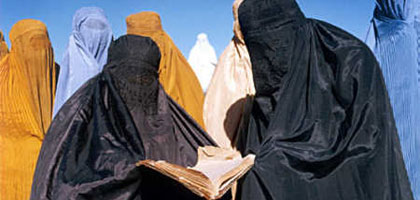
Refuge In The Dust

When Mohsen Makhmalbaf started filming Kandahar his cast hadn't heard of cinema. Nelofer Pazira tells their story.
When Nelofer Pazira, an Afghan woman whose family fled to Canada in 1989, heard from a friend living under Taliban rule in Kandahar that she was thinking of committing suicide, she went to see Iranian film-maker Mohsen Makhmalbaf to ask him to accompany her into Afghanistan to find her friend. At the time he refused, but later he cast Pazira in 'Kandahar', the lightly fictionalised film (selected for competition in Cannes) about her journey and the other real characters they encountered. Here Pazira recounts her experiences during the shoot.
We arrived in the Iranian border village of Niatak in the middle of a dust storm. As we walked along the narrow alleyways it was impossible to see or breathe anything but dust. For our 13-man film crew from Tehran and myself, conditions seemed unbearable. But around us life went on: refugee women burned bushes to cook barley and wheat bread; their children played barefoot in the dust.
Niatak was unfit for human habitation in other ways too. There was no electricity, no clean water and no proper sewerage system. Most of the population suffered from malnutrition, and malaria, tuberculosis and bronchitis were rife. But for the Afghan refugees, it was an earthly paradise compared with their war-ravaged villages inside Afghanistan.
To get our crew to Niatak Makhmalbaf had had to obtain permission from what he described as 'seven different governments' inside and outside Iran. And once we were there we still had to persuade the authorities in charge of the village and the heads of each of the three Afghan tribes who inhabited it to let us film. Each of them seized his chance to cut a deal.
The Iranian authorities wanted to use the film to convey the message that the Afghan refugees were not only an economic burden, but also social misfits and criminal by nature. The head of each tribe sought to increase his authority within the community and his tribe's status vis à vis its rivals. For several days the tribal chiefs would greet us with the words: 'Hopefully tomorrow we will talk to the people and ask them to help you.' That tomorrow never came.
One afternoon we discovered a group of women and children who'd taken refuge in a ruin in the desert bordering the village. The Taliban had slaughtered their menfolk in a recent attack on the central province of Bamyian. A 12-year-old girl collapsed and when we rushed her to hospital we discovered she was on the verge of starvation. She wasn't the only one. So instead of starting to film we went to the nearby market to buy food for the famished families. When we came back we found the Iranian authorities had just transported them to another camp and they were to be deported back home to face their tormentors. All our good intentions, technical expertise and expensive Japanese cameras were helpless in the face of the complexities of this reality and our early optimism was gradually replaced by exhaustion, guilt and anger at the world's indifference towards such human misery.
Kandahar became a collection of stories about the poverty and tragedy caused by the war in Afghanistan. The linking thread is the last stage of my own character Nafas' journey to Afghanistan from Canada to save her sister's life. Injured in a landmine explosion while fleeing the country several years earlier, Nafas' sister has been left alone, after the death of their father, in a house in Kandahar. She has written to Nafas to tell her she is planning to commit suicide at the next eclipse of the sun, in three days' time. In the race to get to Kandahar to save her, Nafas meets other characters who accompany her for part of her journey. Though the basic storyline was fixed, the people we met as we were filming inspired the events that punctuate Nafas' journey.
The first group is an Afghan family returning from Iran. The man, his children and three wives (with Nafas pretending to be the fourth) set off for Kandahar but on the way they're robbed, leaving them no option but to return to Iran and remain refugees.
The next sequence tells the story of a 12-year-old boy, Khak, who's been sent home from a religious school - where his family sends him to be fed as well as taught - because he can't memorise a text from the Quran. When his mother pleads with the headmaster to give him another chance, the teacher gloomily remarks: 'There are lots of hungry boys who will replace Khak.' Khak then tries a variety of ways to make a living to support himself and his widowed mother: reciting the holy book at gravesides; accompanying Nafas as a guide to Kandahar; stealing a ring from a corpse in the hope that he can sell it.
The third tale focuses on a disguised black American, Tabib Sahid, who is the only doctor in a village on the way to Kandahar. But as the story unfolds we learn he's not a medical doctor at all but a Muslim missionary who'd come to Afghanistan with the idea he'd find God by fighting in the Afghan-Russian war. Instead, he discovers his path to God lies in helping others and appoints himself the village's doctor.
Last comes a story about landmines and their victims. In a Red Cross camp Safdar is choosing a pair of artificial legs for his wife who has been injured in a landmine explosion. He has brought her wedding shoes with him to help him find the perfect match. Hyatullah, who lost his right hand in the war, manages to talk the Red Cross doctors into giving him a pair of artificial legs which he then sells to Tabib Sahid and Nafas as they try to persuade him to accompany Nafas to Kandahar. They are discovered by the Taliban at a militia checkpoint.
Before I emigrated to Canada in 1989 I'd spent some years in the Afghan capital of Kabul, where my mother had attended university. Her marriage to my father was a love match; she worked; she wore short skirts. Here the position of women couldn't be more different.
Lawangi participated in the first two days of filming. When she didn't show up on the third day, we tracked her to a relative's house; as she tied the door of the shabby hut with small pieces of thread so she could join us on set she explained that her mother had died two years ago and she had to look after her two younger brothers. But at midday she came to me in tears. 'My father's arrived,' she murmured. 'He'll kill me if I don't go home now. I have to cook bread for him. He beats me as if he's mad.' She showed me her bruised arms. I asked her if she wanted me to come to her home and talk to her father but she begged me not to. 'If he knows I told you this, he'll beat me even harder. Please don't come. I must go.' Zarbibi's father also stopped her from participating; this time I tried explain the situation but he refused to listen. We never saw her in the film again.
One day an elderly woman shouted at me in front of a large group of silent men. 'Go home, you shameless woman,' she said. 'Do you have no honour, to speak to men in public and work with them like this?' Yet another woman begged me to talk to the head of her tribe. She said that if he told the men in the mosque that they should let their wives work, she'd be able to come and film with us. 'My husband has two other wives. We don't have enough to eat. I need the money,' she explained with embarrassment. The head of the tribe declined to speak.
Few of the 5,000 Afghans in Niatak had heard of movies; even fewer had seen one. So it was difficult enough to explain what we were doing, let alone to persuade them to participate. Half of each day was spent trying to convince people to appear, and even those who agreed to help - out of interest, curiosity, or for the money - usually failed to show up the following day so we had to throw away complete scenes and start again with another actor. (An elderly man who stayed the course told me the other men in the camp laughed at him for taking part. 'I've lost my honour and dignity by participating in a film. They call me 'sold out'.') The rest of our time was spent keeping the noisy crowd at bay - for the people of Niatak, we were a spectator sport and they didn't want to miss a scene. Makhmalbaf would start each day smiling, but by the end would have lost his voice from shouting and screaming, negotiating ceaselessly, trying to control the crowd. Filming so much pain and misery drowned us in depression.
My reason for making this film was to tell the story of a people's devastation and a country's destruction. Divided along ethnic, linguistic and tribal lines, laid low by mistrust and past betrayals, unwilling to forgive and hardened by a life of exile, these people's lives reflect the state of their war-shattered country. Our film may not be able to draw the world's attention to the problems of Afghanistan but our presence in the village may have left a crack in that cruel wall. Which is why I want to make more films about Afghanistan - this time as a director.
